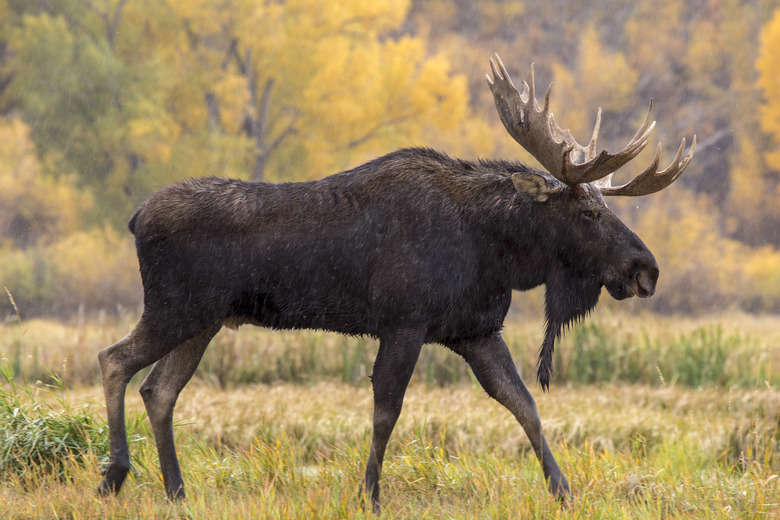How To Distinguish Between A Cow And A Bull Moose
If the plural of goose is geese, the plural of moose must be meese, right? Nope, it's moose, and that's just one of the mistakes people make when referring to the largest member of the deer family. The moose (Alces americanus) isn't the national animal of Canada (that's the beaver). It ranges throughout Alaska and as far south as Colorado in the Rocky Mountains. The word "moose," which means twig-eater, comes from the Algonquin people and reflects the fact that the animal, which can weigh as much as 1,600 pounds, subsists on a vegetarian diet. Like cattle, male moose are bulls while females are cows. If you come across a moose, or you happen to be tracking one, you can distinguish a bull from a cow by noting a few telltale characteristics.
The Moose Bull Is Larger Than the Cow
The Moose Bull Is Larger Than the Cow
Moose are big. They stand about 6 feet, as measured from shoulder to hoof, which makes them the tallest mammals in North America. A moose bull can weigh from 1,200 to 1,600 pounds, but a cow is slightly smaller, weighing anywhere from 800 to 1,300 pounds. To maintain this weight, moose must be constantly grazing. An average moose needs to consume almost 10,000 calories a day to maintain its body weight. That translates to about 70 pounds of catkins, grasses, leaves and woody bushes per day.
Only the Male Moose Has Antlers
Only the Male Moose Has Antlers
A full set of moose antlers is an impressive sight, whether its sitting on the animal's head or lying on the ground after the animal has shed them, which they do every year. Only the males have antlers, which can spread as much as 5 feet across from tip to tip. If the male moose has recently shed its antlers, you'll still see a scar on either side of his head from which a new set will soon start growing. The cow moose has no such scars, and you'll never see her sporting antlers.
The Female Has a White Vulva Patch
The Female Has a White Vulva Patch
If you happen to approach a moose from the rear, you can still distinguish a cow from a bull, but you shouldn't get too close. Moose are docile, but they are territorial, and they can be aggressive during mating season. A moose can run at a speed of 35 miles per hour and will easily overtake you. Luckily, you don't have to get close to notice the white vulva patch of the female. It stands out prominently from the dark strands of hollow insulating fur covering her hindquarters. Males have no such white patch on their hindquarters.
Are You Tracking a Cow Moose or a Bull?
Are You Tracking a Cow Moose or a Bull?
Expert trackers can tell the sex of a moose by looking at its hoof imprints in the mud or snow, which is important for hunters, because cows are often protected. Because females give birth, they have a wider pelvic girdle than males, and the distance between the rear hoof prints is wider than the distance between their front prints. For the male moose, the prints are either in line or the distance between the front prints is slightly larger than the distance between the rear prints.
When tracking a moose in the snow, look for urine spots. If they are directly between the tracks made by the hind legs, they are probably made by a cow. Spots that splay out in an oval shape between the front and hind legs indicate a bull. The difference is due to moose anatomy.
Cite This Article
MLA
Deziel, Chris. "How To Distinguish Between A Cow And A Bull Moose" sciencing.com, https://www.sciencing.com/distinguish-between-cow-bull-moose-8107215/. 22 November 2019.
APA
Deziel, Chris. (2019, November 22). How To Distinguish Between A Cow And A Bull Moose. sciencing.com. Retrieved from https://www.sciencing.com/distinguish-between-cow-bull-moose-8107215/
Chicago
Deziel, Chris. How To Distinguish Between A Cow And A Bull Moose last modified March 24, 2022. https://www.sciencing.com/distinguish-between-cow-bull-moose-8107215/
